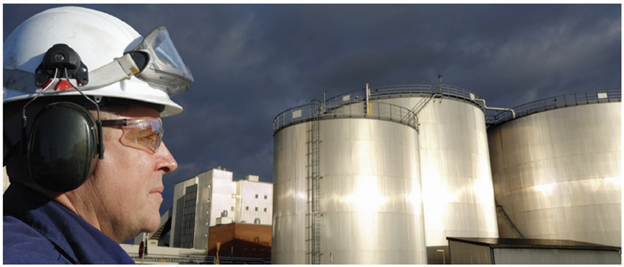
As environmental health and safety specialists, it is our job to ensure that all storage tanks are properly maintained and secure. Unfortunately, this isn’t always the case, as contaminated storage tanks can present a major risk to public health. Contaminated storage tanks can lead to serious illnesses and even death if not dealt with in an appropriate manner. In this article, we will discuss the dangers associated with contaminated storage tanks, as well as what steps must be taken to prevent contamination from occurring in the first place.
It is important to prioritize regular tank inspections to prevent these risks. By identifying any potential issues early on, you can take action to address them before they escalate and become a danger to your health and the environment. Professional tank inspections can provide you with the peace of mind that your storage tanks are in good condition and safe to use. Don’t overlook the importance of tank inspections and take action to protect yourself and others from the potential dangers of contaminated tanks.
Contamination of any kind should never be taken lightly – particularly when dealing with something as dangerous as a faulty storage tank. It is vital for us to take proactive steps towards preventing contamination before it has a chance to occur. We must also know how to identify signs of contamination so we can act quickly if necessary. In this article, we’ll look at exactly how you can do just that!
Definition Of Contaminated Storage Tanks
Contaminated storage tanks are a growing concern for environmental health and safety specialists. According to a recent survey, over 500 million gallons of contaminated water is released into the environment each year from tank contamination incidents. It’s important for everyone to understand what constitutes as a contaminated storage tank in order to identify and prevent future occurrences.
A contaminated storage tank can be defined as any vessel that holds liquid or gas which has been impacted by pollution due to an incident within the system. Contamination sources can range from chemical spills on-site, improper disposal methods such as dumping waste products into the tank, or natural disasters causing flooding or other hazardous material releases near the storage facility. Tank contamination causes may also include poor maintenance practices such as not regularly inspecting pipes or valves leading up to the tank, allowing debris and other contaminants to enter it unnoticed.
In addition, if there is an undetected leak in the containment area surrounding your tank, chemicals and pollutants could seep through porous walls and cause further damage without warning signs showing until it’s too late. Identifying potential threats before they become issues is key to preventing serious cases of contamination in tanks; understanding how these situations arise is critical for effective risk management planning going forward. Transitioning now into discussing sources of contamination will help us better comprehend how dangerous this issue really is..
Sources Of Contamination
The sources of contamination in storage tanks can be divided into two categories: environmental and human-caused. Environmental sources are primarily related to pollution, including groundwater contamination from oil storage tanks or chemical storage tanks, toxic waste disposal sites, sewage runoff, and septic tank leakage. Human-caused sources include fuel spills or leaks due to improper maintenance and the introduction of hazardous materials into a tank by accident or negligence.
No matter what the source is, contaminated storage tanks can have serious consequences for both people and the environment if not properly managed. The presence of contaminants such as volatile organic compounds (VOCs) and heavy metals can pose serious health risks to those who may come into contact with them through ingestion, inhalation, or skin absorption. In addition, these substances can also leach into nearby water sources causing further contamination that affects drinking water supplies and aquatic life.
It’s essential that all potential sources of contamination in storage tanks are identified and addressed promptly so they don’t become a major issue down the line. This includes regular inspections of all types of tanks used onsite to ensure no signs of deterioration have occurred over time as well as implementing measures like spill containment systems to prevent accidental releases from occurring in the first place. Taking steps now will help minimize any long-term damage that could occur due to neglected issues with contaminated storage tanks. With this knowledge in mind, we can move forward towards learning about the health risks associated with exposure to contaminants found within them.
Health Risks From Contamination
It’s ironic; the very thing we rely on for our health and wellbeing, water, can lead to its destruction in contaminated storage tanks. But that’s not all – when chemicals are stored improperly or leached into drinking or groundwater supplies, there is a potential for significant health risks from exposure.
Chemicals found in these storage tanks can range from those used in industrial processes to fuel and oils. Some of these may cause skin problems such as irritation and rashes while others have the potential to be more dangerous if ingested through drinking water or inhaled through air quality contamination. Groundwater contamination due to improper handling of hazardous materials can also result in serious long-term illnesses including cancer, kidney failure, neurological disorders and even death in extreme cases.
What’s worse is that this type of environmental pollution knows no boundaries – it affects both humans and wildlife alike. As a society, we must be responsible stewards of our environment by recognizing the importance of proper safety protocols around storing hazardous materials like those found in storage tanks. We need to take measures now to prevent further damage before it becomes an irreversible problem with dire consequences for everyone involved. The next section will explore the environmental effects of contamination caused by these unsafe practices.
Environmental Effects Of Contamination
Storage tanks can be a major source of environmental contamination when not properly managed. Contaminated storage tanks have the potential to cause both short-term and long-term harm to the environment, including water, air and soil pollution. Groundwater pollution is especially dangerous as it affects drinking water sources. When hazardous substances from storage tanks leak into groundwater, they may contaminate nearby wells or other bodies of water used for human consumption.
Soil contamination occurs when hazardous materials are absorbed into the ground near a tank site due to leakage or spills. This can lead to contaminated crops or vegetation grown in that area as well as health risks posed by exposure to toxic chemicals in the soil. Additionally, air pollution may result if volatile organic compounds (VOCs) escape through vents and cracks in the tank walls. VOCs can be particularly damaging because they often remain suspended in the atmosphere for long periods of time before dispersing.
Finally, surface runoff poses another threat; contaminants such as solvents and oil can reach rivers and streams during rain events, leading to serious cases of water contamination. In some cases, these pollutants will travel downstream until reaching large lakes or oceans where aquatic life is affected negatively by their presence. Moving on from here, detection and prevention methods must be considered for containment purposes…
Detection And Prevention Methods
The risks associated with contaminated storage tanks are as real and dangerous as a hungry lion prowling through the jungle. That is why detection and prevention methods must be employed to ensure that these hazardous materials stay contained within the tank. Proper leak detection, water testing, annual inspections, tank sealing and preventive maintenance should all be used to minimize risk of contamination.
Leak detection can help identify any cracks or openings in the tank where contaminants could escape from. A thorough visual inspection of areas around the tank can also serve as an early warning sign for potential leaks. Water testing should also be conducted at least once per year to detect any changes in pH levels which may indicate a potential problem before it becomes more serious.
In addition to leak detection, annual inspections of storage tanks need to take place so that professionals can check on sealants and other components needed for proper containment of hazardous materials. Tank sealing is another important factor when preventing leakage since small imperfections in seals can lead to major issues if left unchecked over time. Finally, preventive maintenance protocols should be implemented regularly such as checking valves and gaskets for damage or wear-and-tear from use over time.
By following regular safety protocols like those listed above, companies will have fewer chances of experiencing environmental disasters due to leaking storage tanks containing hazardous material. It is essential that everyone involved follows regulations and guidelines set forth by local authorities in order to protect public health and safety – this is subject to much scrutiny not just locally but nationally as well given how damaging pollution incidents can be for our environment.
Regulations And Guidelines
Storage tanks are subject to regulations and guidelines designed to protect the environment from contamination. Tank contamination laws, standards, and regulations help ensure that any potential contaminants in a storage tank do not spread or cause harm. The Environmental Protection Agency (EPA) has established specific containment requirements for all types of storage tanks including underground fuel and oil tanks. These rules include safety measures such as regular inspections, leak detection systems, monitoring equipment, and appropriate maintenance procedures.
It is particularly important that owners of contaminated tanks adhere to these regulations as failure to comply with them can result in serious environmental damage. As part of their responsibility under EPA regulations, tank owners must take steps to contain any contaminants present within the tank. This includes implementing proper spill prevention protocols, performing periodic testing on stored substances, and taking action when needed to prevent further contamination from occurring.
Overall, understanding the regulations related to storage tanks helps ensure that any possible risks associated with tank contamination are minimized. With this knowledge in hand owners can take proactive steps to maintain safe conditions around their tanks while also helping protect the environment from potentially hazardous materials. To address existing contamination issues it’s necessary to move onto cleanup strategies…
Cleanup Strategies
The consequences of contamination from storage tanks can be devastating – if not addressed in a timely fashion. To mitigate the potential for environmental damage, there must be proper procedures and protocols in place to ensure that any hazardous materials found within these tanks are properly contained and treated. With this in mind, let us look at some key strategies for tank cleaning and decontamination:
– Tank Cleaning: This involves removing all accumulated sediment from the bottom of the tank using specialized equipment such as vacuum trucks or high-pressure water jets. It is important to have the right personnel and tools available when conducting this type of work so that no additional contaminants are introduced into the environment.
– Water Purification: In cases where contaminated water has been released into an area, it may be necessary to use techniques such as filtration or chemical treatment to remove harmful particles and bacteria. This process should always involve testing samples before they are deemed safe for consumption by humans or animals.
– Decontamination Techniques: Depending on the nature of the hazard present, different methods may need to be employed to reduce its concentration or render it harmless. For example, oil spills may require remediation through physical barriers like booms or absorbent materials; whereas hazardous waste removal could call for incineration or encapsulation techniques.
– Oil Spill Remediation: If an oil spill occurs near a body of water, then special measures must be taken to prevent further pollution while also restoring affected habitats and ecosystems. These steps include skimming off surface oil with floating containment boom systems, deploying dispersants onto spilled fuel slick areas, collecting volatile organic compounds (VOCs), aerating impacted waters, etc., depending upon the severity of the incident.
By taking prompt action after discovering a contaminant issue within a storage tank, significant harm to both people and wildlife can be avoided – making sure that every precaution is taken during clean up operations is essential for protecting our environment going forward. Now we will discuss cost implications associated with cleanup efforts which can vary greatly depending on factors such as location, size of affected area, complexity of project requirements etc.
Cost Implications Of Cleanup
Contaminated storage tanks can have costly implications. Cleanup costs vary depending on the level of environmental damage and health risks associated with them. The cost is often dependent upon the severity of contamination, and factors such as labor and disposal fees that may be incurred in order to remediate it. For example, if there has been a large spill or leak from a tank, then significant cleanup efforts must take place before any other actions are taken. This could include removal of contaminated soil, treatment of affected groundwater sources, and even redesigning tanks for better safety measures.
In addition to these direct costs, indirect expenses such as lost profits due to delayed operations or decreased production times should also be accounted for when considering the overall cost of cleaning up a contaminated storage tank. In some cases, legal action against those responsible for causing the contamination may also be necessary in order to fully cover all expenses related to restoring an area back to its original state.
It’s important to recognize that contamination from storage tanks can result in long-term effects on human health and the environment if left unchecked. Therefore, taking steps now to ensure proper maintenance and containment methods can help prevent further financial losses later down the line.
Long-Term Effects On Human Health
The contamination of storage tanks can have far-reaching effects on human health. Our bodies can be exposed to toxic chemicals and metals over a long period, leading to serious illnesses that could last for years. In addition, contaminated water sources used by humans can lead to direct exposure through ingestion or inhalation of the toxins present in these substances.
Exposure to contaminants from storage tanks may also affect vital organs such as the kidneys and liver, which are responsible for filtering out harmful elements from our body. Long-term exposure has been linked to various types of cancer, neurological disorders, respiratory diseases, chronic fatigue syndrome and reproductive issues.
It is essential that we take all necessary steps to ensure that storage tanks do not become contaminated with pollutants or other hazardous materials. This will help protect people from being exposed to potentially dangerous long-term health effects caused by this type of contamination. Moving forward, it is important that we understand how contaminants from storage tanks impact local ecosystems so we can work together towards an effective solution.
Impact On Local Ecosystems
The dangers of contaminated storage tanks are far reaching and can impact local ecosystems in devastating ways. To put it bluntly, these tanks pose a serious threat to the environment if not managed carefully. From water contamination to soil pollution and wildlife endangerment, contaminated storage tanks could harm nearby habitats.
Firstly, when toxic chemicals enter an ecosystem, they can pollute the surface or groundwater for miles around. Depending on the toxicity of the contaminants released from a tank, this water contamination can have disastrous effects on local wildlife and their ability to survive in the area. Secondly, any hazardous materials that spill over into nearby soils may also cause long-term issues with plant growth as well as further disruption of food sources for animals living there. Finally, should groundwaters become polluted by contaminated storage tanks then both flora and fauna will suffer greatly due to a lack of clean drinking water.
It’s therefore essential that citizens take steps to prevent such disasters from occurring in their community by making sure that all storage tanks are handled with care and regularly inspected for signs of damage or leaks. Taking proper precautions now can help preserve our delicate ecosystems and protect them against potential threats posed by faulty containment systems in the future.






